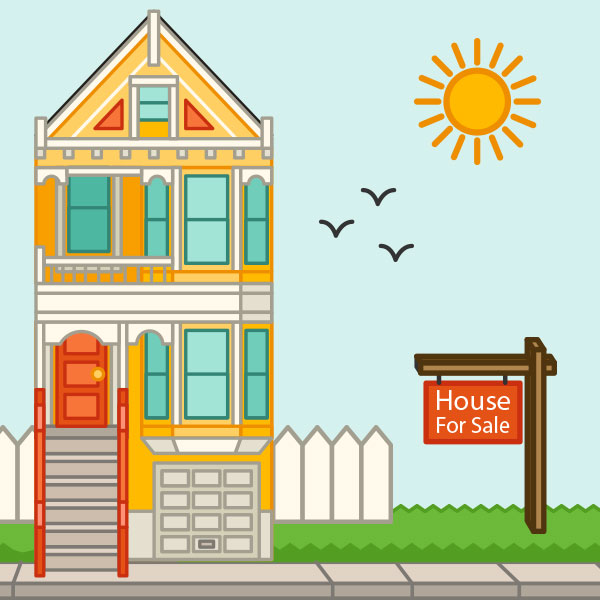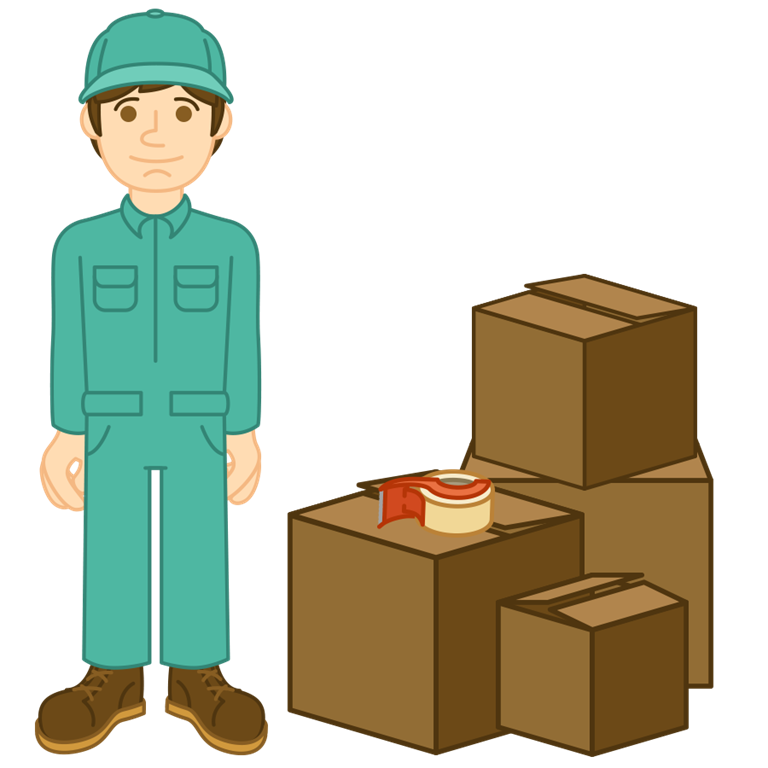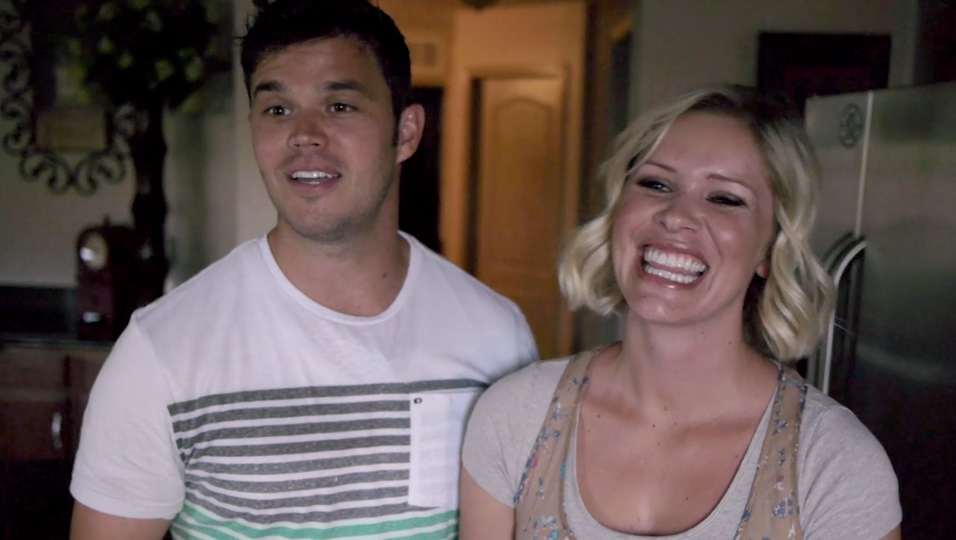 When you’re preparing to move, we know you’ve got a lot on your mind. Packing, cleaning, using Moveline to select a mover — it’s plenty to think about. But if you’re selling a home (or buying one), you’ve got something else to consider: curb appeal. Like any first impression, it matters more than you might think. Here’s why, along with a few helpful tips to get you started on helping your home razzle-dazzle ‘em from the very first glance.
When you’re preparing to move, we know you’ve got a lot on your mind. Packing, cleaning, using Moveline to select a mover — it’s plenty to think about. But if you’re selling a home (or buying one), you’ve got something else to consider: curb appeal. Like any first impression, it matters more than you might think. Here’s why, along with a few helpful tips to get you started on helping your home razzle-dazzle ‘em from the very first glance.
It’s all about the gut
When a potential buyer envisions themselves living in your home (and trust us, they will), you want them thinking about enjoying backyard barbeques and celebrating birthday parties, not doing repair work and reseeding the lawn. A home with great curb appeal tells a buyer, “Hey, I’ve been cared for and I’m in great shape. You can trust me. Just think about the great times you’ll have here. I’m ready for you.” That first few seconds can make the difference between scheduling a tour and missing out on a sale.
Say “hello” to the neighborhood
If you’re buying, similar principles apply. You’re like the new guy or gal at a job. When you come into a neighborhood, your neighbors might wonder what you’re like. Of course, sharing cupcakes is a great way to introduce yourself. But another is to do a little sprucing up of your new place’s exterior. Even little touches show the neighborhood you’ll be taking care of your home, which benefits everyone (especially since property values are affected by the homes nearby). You might even earn a neighborly dinner invite or two.
You don’t have to be Bob Vila — or Donald Trump
We’re not suggesting you take on major renovations in either scenario. We’re talking about easy enhancements that don’t take long and don’t make your wallet cry, either:
- Keep it clean. Make sure your porches, driveway, and yard are trash-free.
- Trim bushes, lay down some fresh mulch, and consider planting a few flowers.
- Swap old house numbers for clean aluminum or steel numbers that are easy to read from the street.
- Replace exterior lighting fixtures and add a few landscaping lights to illuminate the house and walkways.
- Refresh worn paint on shutters, doors and windowpanes.
- Wash your windows and screens.
- Mow the lawn on an angle, ideally along an existing landscape line (a mulch bed, sidewalk, etc).
- Get new porch furniture so prospective buyers (or new neighbors) will imagine themselves enjoying a nice summer evening there.
Look beyond big box stores
The popular home improvement stores can be great, but some quick visits elsewhere might lead you to cool, unexpected projects. Your local bookstore might have some books on exterior design that could give you ideas. Craft stores can be great resources for affordable raw materials. Have a trendy nursery nearby? See how they showcase their plants and steal a technique. Of course, you can get lots of great suggestions from websites like Houzz, Pinterest, and even a Google image search.
Accentuate the positive
Every home is unique, so take a fresh look at yours. What positive aspects can you showcase? What less-than-ideal features can you steer eyes away from? With minimal cash out and a little bit of elbow grease, you can restore the shine to almost any home. Whether you’re selling or buying, that means nothing but good things for home — old or new.
Of course, if you’re planning a move, there’s really only one spot to check out: Moveline. We simplify the inventory process, get you fair and accurate quotes from reputable movers, and oversee your move from beginning to end. All without costing you a dime. Let us make your move easier than you imagined, freeing you up to spend time on more important things. Like those azaleas.
 So you’re heading to a new city. Maybe it’s for a new job, or a relationship, or to be closer to (or further from) family. Whatever the reason, if you’ve lived in your current home for a while, you’ve put down roots. You’ve got friends. Memories. Routines. Favorite haunts. Favorite smells. All the little things that make a place a home. They can feel like a form of gravity, pulling you back even when you’re ready to leave. That’s normal. Here are a few tips to help make the transition a little easier for you.
So you’re heading to a new city. Maybe it’s for a new job, or a relationship, or to be closer to (or further from) family. Whatever the reason, if you’ve lived in your current home for a while, you’ve put down roots. You’ve got friends. Memories. Routines. Favorite haunts. Favorite smells. All the little things that make a place a home. They can feel like a form of gravity, pulling you back even when you’re ready to leave. That’s normal. Here are a few tips to help make the transition a little easier for you.
Make your memories real
It’s nice to have something with you that reminds you of the places you’ve been. So, make a memory stone. Grab a camera and document all of your favorite places, collecting photos and smiles and memories along the way. Collect a few souvenirs you can only find in that city. The point is, photos, movies, recordings, and physical objects can trigger and help preserve memories. Don’t overdo it, of course – you’re not trying to preserve your live in amber here. But in your new home, when you have your morning coffee in a mug from that little coffee shop next to your old place, you’ll be reminded of all the good times you had there.
Network, baby
We live in the most interconnected time in human history. Odds are, you know someone (or someone that knows someone) in the city you’re moving to. Especially if you’re Kevin Bacon. Not Kevin Bacon? Ok, what about professional organizations or community service groups you’ve participated in? If they have a local chapter in your new city, that’s a great way to meet new people with similar interests. If you play music, hit the local guitar shop. Like to cook (or eat)? Take a cooking class. Do a little research before your move, and make a list of places and organizations you want to check out.
Embrace the new
Moving can be a time of reinvention. It’s a refreshing opportunity to see, do, and even be something new. So get out there and explore all the things that fell outside your routine in your previous locale. Pick up a new hobby. Try hiking if you’ve never done it. Sample local cuisine that you might not have ever tried before. Grab your calendar and a local paper and check out the events section. Find at least one new thing to do each week.
Put down roots
To make your new city and new place to feel like home, treat it like home. Don’t leave half your things in boxes for, oh, two years. Get stuff up on your walls. Buy new furniture if you need it. Invest in your new home and make it yours. It’s like any relationship. You have to commit to make it work. As you explore your neighborhood, you’ll naturally begin finding people and places you like. Embrace that process. These new people and places will begin to fill in your days and make this unfamiliar place suddenly feel familiar.
By following a few of these steps, you’ll be on your way to turning your new place into your new home. Soon, it’ll feel just right. While Moveline can’t help you with your scrapbooking or networking, we can help you make all the right decisions when planning your move. Don’t go it alone — give us a shout!
 Summertime means sand, sun, vacations… and an increased energy bill (womp womp), particularly for people who are moving in the middle of the summer and getting used to a new home and a new utility payment. The world wide web offers a lot of repetitive energy saving tips, but being the customer service fanatics that we are, Moveline is delighted to bring you a collective of only the best and most effective summer energy saving tips. Here they are, in one place, slimmed down to their need-to-know essence.
Summertime means sand, sun, vacations… and an increased energy bill (womp womp), particularly for people who are moving in the middle of the summer and getting used to a new home and a new utility payment. The world wide web offers a lot of repetitive energy saving tips, but being the customer service fanatics that we are, Moveline is delighted to bring you a collective of only the best and most effective summer energy saving tips. Here they are, in one place, slimmed down to their need-to-know essence.
Top 5 tips for saving energy in summer
- Reduce the use of appliances. This goes for all of ‘em: dishwashers, stovetops, washing machines, dryers and the other usual suspects. Cut down on their use as much as you can, and when you do use them, make sure it’s during the cooler times of the day and that they’re full loads. Put lids on stovetop items when cooking and air dry dishes and clothes whenever possible.
- Unplug electronics. Whenever you’re not using your TV, computer, iPad, DVD player, etc — even if they’re in sleep or airplane mode — they’re still using energy if they’re plugged in.
- Use less hot water. From your shower to your hot water kettle, less hot water means less energy to heat it up. Take cooler, shorter showers and set your water heater to 120 degrees.
- Optimize your air conditioning. Try to keep your thermostat to 78 when you’re at home and 85 when you’re away. Get a tune-up on your air conditioner and replace its filters monthly. Close windows and shades during the day and use fans to keep air moving for a cooler feel. And for long-term savings, seal off any air leaks in your house (check out the most common ones here).
- Go high-efficiency. If you’re really going for an overhaul, replace outdated appliances with Energy Star ones. If you’re not ready for that big of a commitment, start with lightbulbs and smaller appliances like toasters. (Did you know LED bulbs last almost 50 times longer than incandescent bulbs? That’s a 75 percent savings for you on light bulbs alone in the long-term, and a lot less time spent changing those suckers too. Oh, and they use one-sixth the energy. That’s a win-win for your wallet and the earth you live on.)
More ways to cut your energy bill
Don’t overlook these alternatives for saving energy over the summer:
- Get a free home energy audit. Most utilities companies offer free audits to find where your home energy inefficient. Take a first step here.
- Fire up the grill. Each time you grill outside rather than cook inside, you’re saving money on your energy bill. (Grilling steaks? Don’t forget to invite us over.)
- Take care of your body’s energy. Remember those hot summer days when you came home and immediately cranked up the AC for a quick cool down? Cut down on the need for this energy spike by taking care of yourself throughout the day. It’s simple, actually: drink plenty of water to stay hydrated, and wear lighter clothing.
- Trees are the bee’s knees. Thoughtfully-planted trees can help by reducing your home’s exposure to the sun. Use an online calculator to locate those sweet spots.
- Replace electric lights with candles. Even one night a week will make a little dent in the bill. (Throw in board games and you’ve got a raging good time.)
Whether it’s summertime energy saving tips, DIY packing or pointers on how to live with a roommate, Moveline’s got you covered. Let us help you with your move — we’ll get you and all of your stuff from final goodbye to first hello without an empty wallet and with your sanity. Give us a call or visit our site and get started today.
 One of the coolest things about launching Moveline has been the feedback we get from the folks we’ve helped move. When they express their happiness over working with us, when they recommend us to their friends and family, when they tell us we’ve reduced their stress — those are the moments that reinvigorate us and make us work even harder to solve a problem nearly all of us will face at some point in our lives. The more moves we navigate, the better we can make the process and the greater an impact we can have on people’s lives; that’s why it’s so important for us to grow, to improve our product, and to spread the word about our services. So today, we’re proud to announce that we’ve closed a $3 million funding round led by ff Venture Capital (ffVC), with participation from Vegas Tech Fund, Tony Hsieh, and Quotidian Ventures, in addition to several among our original investors.
One of the coolest things about launching Moveline has been the feedback we get from the folks we’ve helped move. When they express their happiness over working with us, when they recommend us to their friends and family, when they tell us we’ve reduced their stress — those are the moments that reinvigorate us and make us work even harder to solve a problem nearly all of us will face at some point in our lives. The more moves we navigate, the better we can make the process and the greater an impact we can have on people’s lives; that’s why it’s so important for us to grow, to improve our product, and to spread the word about our services. So today, we’re proud to announce that we’ve closed a $3 million funding round led by ff Venture Capital (ffVC), with participation from Vegas Tech Fund, Tony Hsieh, and Quotidian Ventures, in addition to several among our original investors.
It’s been a year of growth and evolution. Relocating our headquarters from New York to Las Vegas last year is paying off in spades; while we’ve maintained fantastic relationships with the people and places that gave us our start, we’ve bloomed into the fastest-growing startup in Downtown Vegas, and just last week the Technology Business Alliance of Nevada honored us with its 2014 Tech Transplant Award. While the move was a calculated risk, sometimes, venturing out into the great unknown and making a big, bold move is necessary for success, plain and simple. And incidentally, we knew just where to go to plan ours.
If you’re about to make a move of your own — a literal one, that is — we’re here to help. Thanks to the support of our esteemed investors, we plan on sticking around for a really, really long time and delighting as many people as possible.
Moveline is a technology company powered by people who help people plan and save money on a move. Comparing apples-to-apples quotes, streamlining the inventory process and giving expert moving advice is all in a day’s work for movers, who dedicate themselves every day to make moving suck less. Get started with us now and let us help you get a move on.
 At some point during your move, whether you need a box or two to throw some small knickknacks in or you’ve decided to pack everything yourself, you’re probably going to need to get your hands on some boxes. Since this elusive task can be harder than it seems, we’re here to help and share some tips on not only where to get boxes, but where to get the right ones. (And here’s what’s cool: if it’s all too much to deal with, Moveline can handle it for you completely.)
At some point during your move, whether you need a box or two to throw some small knickknacks in or you’ve decided to pack everything yourself, you’re probably going to need to get your hands on some boxes. Since this elusive task can be harder than it seems, we’re here to help and share some tips on not only where to get boxes, but where to get the right ones. (And here’s what’s cool: if it’s all too much to deal with, Moveline can handle it for you completely.)
Plan before you pack
Before you go box hunting, it’s important to know what kind of box you’re looking for because not all boxes are created equal. Box ratings are based on the results of an Edge Crush Test (ECT), which you can find stamped on the bottom of the box. Boxes range from 23 to 82 ECT; the higher the score, the sturdier the box.
Figuring out how much of your stuff requires high ECT boxes and how much will be just fine in less sturdy boxes is key. Breakable or fragile things and high-density items (like hardcover books and statues) belong in high ECT boxes. Things like linens and dry, uncanned food (you know, all that instant mac and cheese you bought at Costco) are ideal candidates for low ECT boxes — items that don’t have a high chance of being damaged by pressure from outside the box, but also won’t damage the box from the inside out either.
Boxes on the cheap
Thanks to the internet age, you might not have to go much farther than your computer to find free (or nearly free) boxes:
- Craigslist (under the “free” category of the For Sale / Wanted section)
- Rummage sales (check your local paper for announcements and addresses)
- Rumgr (an app that brings rummage sales to your smartphone)
- Liquor, grocery, and fast food stores (check out this Facebook group dedicated to the reuse of McDonald’s fry boxes)
- Shopping centers like Walmart, Lowes, and Home Depot
- U-haul’s Customer Connect
Getting the good stuff
For those items that need tougher boxes (or if you want to splurge on tougher boxes since there’s dinero left over after Moveline got you an awesome price on your move), head this way:
If you’re looking to make an eco-friendly move, check out rentable, reusable plastic bins from suppliers like Rent A Green Box, Uline’s eco friendly line, EZ Bins, Rent-a-Crate, Bungo Box, and Frogbox (just make sure the option you choose is available in the cities where you need them).
From acquiring boxes to finding the best solution for your move, Moveline is here to help. We get you guaranteed quotes (including boxes and packing materials if you don’t feel like tracking them down on your own), and we’ll stick with you the whole way, making sure your stuff is well taken care of and that your stress level stays as low as possible. Check out more about what Moveline can do for you here.
 Seattle, the crown jewel of the Pacific Northwest, is a city with lots of short-term housing opportunities. According to local realtor Ryan Halset, “Our economy was not hit as hard as other areas during the economic downturn, and companies such as Microsoft and Amazon have continued to hire. Temporary housing is a consistent need for people moving to the area… you’ll find that the cost of temporary housing is typically more than (that of) permanent, but it can be a great option while you learn about the unique neighborhoods of Seattle.” So, we’ve put together a handy primer on finding short-term housing in the Seattle area — Washington State’s cultural epicenter.
Seattle, the crown jewel of the Pacific Northwest, is a city with lots of short-term housing opportunities. According to local realtor Ryan Halset, “Our economy was not hit as hard as other areas during the economic downturn, and companies such as Microsoft and Amazon have continued to hire. Temporary housing is a consistent need for people moving to the area… you’ll find that the cost of temporary housing is typically more than (that of) permanent, but it can be a great option while you learn about the unique neighborhoods of Seattle.” So, we’ve put together a handy primer on finding short-term housing in the Seattle area — Washington State’s cultural epicenter.
Start your search by checking out Moveline’s own guide for new Seattle residents. The first section, with its profiles of the city’s neighborhoods, will give you a head start. Two other great sources for orienting you to the city from afar are Trover.com and COEverywhere.com. Trover, the brainchild of Seattle resident Jason Karas, let’s you see photos of what people who live in Seattle like best — coffee shops, galleries, and all kinds of cool places to go, while COEverywhere connects you to the social activity going on in the location of your choice, linking to tweets, Facebook posts, photos, Groupon deals, and more for any neighborhood you click on the site’s map.
To get a feel for what the real estate market is like in Seattle, check out Curbed.
Now that you’re acclimated, there’s nothing better than word of mouth and personal references from friends, relatives or colleagues when you’re looking for short-term accommodation. Failing that, though, you’ve got plenty of alternatives.
The old stand-bys
You probably already know about Craigslist and Airbnb; indeed, both sites are good starting points for your search. A recent check of those sites came up with a furnished studio with a kitchenette one block from the Space Needle for $1695 on Craigslist, and a hilltop condo with one bedroom in the Queen Anne neighborhood for $2575 per month on Airbnb.
Sublets
Plenty of national sites exist to help you find temporary housing in cities like Seattle Oodle, Hotpads and Ebay classifieds, to name a few — but don’t overlook the local sources, which can help you find hidden gems. Sea to Sky Rentals got its start when the founder decided to sublet an apartment in her own home and recognized it was something that others would want to do, too. Two other locally owned and operated sites are Short-Term Suites, promising postings twice a day, and Seattle Furnished Suites, where a 550-square-foot one bedroom in the “hip & nerdy” Ballard neighborhood was listed for $1395 per month.
Uloop is an ideal source for sublets located near colleges and university campuses — just search by the name of the school you want to be near. And although Live Lovely is primarily for longer term rentals, you can try “month-to-month,” “short-term” or “corporate housing” in the site’s search feature and see what pops up in your range.
Roommates
If you’re okay with sharing space with someone else, try Roomster, Roommates.com and Roomie Match. Roomster has a category called “entire property search” as well if sharing isn’t your thing. On it we recently found a 1 bedroom, one bath with parking included for $750 per month. (And if you need tips on getting along with roommates, we’ve got you covered.)
Corporate housing
There’s no shortage of corporate housing companies with properties to offer in Seattle. This option is typically the most expensive since the accommodations are usually in high-end buildings that offer lots of come-hither amenities like gyms and swimming pools and, in the case of Synergy, even special arrangements for those furry friends on four legs.
If you aren’t bargain hunting and want a one-stop shopping experience, check out the Seattle listings on Aboda, Oakwood, Bridgestreet or Execustay. An Oakwood listing for a one bedroom in a highrise located where Belltown meets Downtown is $176 per night. Monthly rates are available for what promises to be a “vertical neighborhood” with everything you need right in the building, including a movie and game room.
Vacation Rentals
Lots of sites can connect you with a space that the owner wants to rent for a day, a week, a month or longer. Airbnb is exactly that kind of site, and its competitors include Vrbo, Flipkey and HomeAway.
A local vacation rental site, Seattle City Rentals, may have a few nice choices as well; a recent search showed an apartment in a building with five one-bedroom apartments ($650 to 975 per week depending on season) and a stand-alone cottage next door with a bedroom, space for an office and a secluded back patio ($750-$1200 per week).
No matter what route you choose, you’re bound to find something that suits you. Whether you’re moving to Seattle for a short-term stay or a longer haul and just need temporary housing while you get your footing, there’s a home out there with your name on it. And once you find it, let Moveline help you get there. We’ll compare prices on your behalf, get you connected with the right moving services, and have your back every step of the way. Saving money, time, and stress is definitely the way to go, so give us a shout and let us help you get a move on.
 As with most things in life, a successful move begins before the trucks arrive. Smart organizing and packing makes moving easier and more efficient. And while hiring a professional packing team can be a great decision, it doesn’t mean you’re totally off the hook. After all, it’s your stuff that’s at stake!
As with most things in life, a successful move begins before the trucks arrive. Smart organizing and packing makes moving easier and more efficient. And while hiring a professional packing team can be a great decision, it doesn’t mean you’re totally off the hook. After all, it’s your stuff that’s at stake!
Beyond using your own common sense, the following tips will help ensure that the things you value so much end up intact and in the right spot in your new home.
- Clean and organize. Laundry, dishes, tools and other items pack and move easier when they’re not a mess.
- Purge! Go through and pull stuff that you can trash, give away or donate. Remove these items before the packers arrive, or gather it all into one pile and clearly mark it “DO NOT MOVE!”
- Pull items that you’ll move yourself. These normally include medicines/toiletries, enough clothing for the move duration, personal items (electronics/chargers/books), work stuff, jewelry and hazardous items that packers and movers won’t touch. Pack these things ahead of time, or clearly mark them.
- Organize and label rooms. Have all your master bathroom items in your master bathroom, for example, and use signs to mark every room so the packers can mark boxes accordingly. If a large item will switch rooms in the new house, just mark it with its own label.
- Back it up. Use portable hard drives (that you keep with you) or cloud storage to back up any important computers, tablets, etc.
- Mark high-value items as such. Whether it’s a truly valuable vintage record player, or an old music box that has more sentimental value than collector value, this tells packers and movers to take extra care with these items.
- De-clutter. Packing moves faster if the team has surfaces to work on (tables, countertops, etc.) that are clean and open.
- Walk the walk & talk the talk. Tell the packing team your expectations and make sure you’re available if they have questions. Walk through your home before and after the packing job and make sure it’s all done to your satisfaction.
- Prepare for a snack attack. Everyone loves snacks. Have some cold water or lemonade and some cookies or granola bars available to the packing team. Warm chocolate chip cookies earn extra points.
Put in a little legwork ahead of time and you’ll avoid spending the first year in your new home trying to figure out how the can opener ended up with the gardening supplies. For more tips, check out the endless well of helpful articles that is the Moveline blog. And when you’re ready to book your move, don’t go it alone. Give us a shout. We’ll be there with you every step of the way.
 It’s true what they say: opposites attract. But when those opposites are thrown into the life-changing tumult of, say, a cross-country move, an uninvited third wheel can weasel its way into the relationship, and that third wheel’s name is Stress. In the case of one particular husband and wife who recently moved from Arizona to Pennsylvania, their fundamental differences — his wanderlust and her love of staying in one place — were just the first of several sticking points when he got into a dental school that required them to move thousands of miles away. Luckily for them, here at Moveline we’ve helped our fair share of folks move from one place to another, and making relocation easier for couples is one of the many services we offer.
It’s true what they say: opposites attract. But when those opposites are thrown into the life-changing tumult of, say, a cross-country move, an uninvited third wheel can weasel its way into the relationship, and that third wheel’s name is Stress. In the case of one particular husband and wife who recently moved from Arizona to Pennsylvania, their fundamental differences — his wanderlust and her love of staying in one place — were just the first of several sticking points when he got into a dental school that required them to move thousands of miles away. Luckily for them, here at Moveline we’ve helped our fair share of folks move from one place to another, and making relocation easier for couples is one of the many services we offer.
“We tackle things a little bit differently,” she explains. “So for the move, he was thinking, ‘Oh, it’s not gonna be that bad, and I don’t think moving cross-country will require much work, and I think we should do it ourselves,” and I just thought, ‘This is going to be a disaster if we do it ourselves.’”
Not knowing a soul in their soon-to-be adopted city of Pittsburgh, they put their fears aside and dove headfirst into planning the move. Step one: engaging Moveline’s services. With the help of their mover, they got a firm grip on whether or not to hire a mover (verdict: yes) and which things to keep vs. which things to toss before the move, not to mention a great deal on a moving company that saved them not just money, but also quite a few disagreements. And that, of course, is a priceless thing when you’re taking a rather literal leap of faith all the way across the country to an unfamiliar place.
The bottom line, according to our two new Pennsylvanians? “Moveline saves marriages! Just joking. But it sure reduces stress, and the what-ifs of (moving) out there.”
 Packing your stuff yourself is an excellent way to avoid costs when moving, but if you’re taking a DIY approach, the single most important thing to know is what not to pack. Moving professionals are trained to look for normal household items that are actually hazardous and often illegal to ship. Being proactive in the planning process can eliminate the risk for potential surprises (not the good kind) and save time along the way. Because no one wants their moving day to end up in disaster.
Packing your stuff yourself is an excellent way to avoid costs when moving, but if you’re taking a DIY approach, the single most important thing to know is what not to pack. Moving professionals are trained to look for normal household items that are actually hazardous and often illegal to ship. Being proactive in the planning process can eliminate the risk for potential surprises (not the good kind) and save time along the way. Because no one wants their moving day to end up in disaster.
Know what not to pack
Your moving company should provide you with a list of “non-allowables,” an industry term for things professional movers won’t transport. The list not only includes intuitive items like ammunition and gasoline (truck fires are frowned upon), but also less-obvious things such as nail polish and toy chemistry sets.
Below is a list of some of the most common non-allowables, but you can check out a full list here. You might notice that alcohol is included… if you ask us, that’s a perfect excuse to invite all your friends over and throw yourself a little going away shindig.
Think “out of the box” – literally:
- Aerosol cans (regardless of content)
- Flammables (like Sterno, charcoal, lighter fluid, matches, and lighters)
- Nail polish and remover
- Fire extinguishers
- Alcohol
- Any type of gas in bottles or tanks (including propane or oxygen)
- Paints, varnishes, solvents, thinners and oils
- Household cleaners (like ammonia and bleach)
- Batteries
- Ammunition
- Fertilizers and pesticides
Food for thought
Here’s a piece of trivia you probably didn’t know: although they’re not hazardous, perishable foods and plants also pop up on moving companies’ things-not-to-pack list. Even though they’re not flammable or toxic, they can attract bugs, rats, and other pests that could damage your property — zero fun for anyone. Common perishables are things like:
- Frozen or refrigerated food
- Produce
- Open food items
- Plants (indoor and outdoor)
- Fresh herbs
- Flowers
Feel terrible throwing away food, though? No worries; consider donating those perishables to a group like Move For Hunger or a local shelter, soup kitchen, place of worship or safe house.
What to keep handy
Now that you know what you can’t pack, it’s time to think about what you probably shouldn’t pack. We recommend you keep personal items (things like daily necessities, items of sentimental value, and important documents) off of moving trucks as well. It’s kind of like the difference between carry-on and checked baggage when flying: anything that you use on the daily or anything that would be inconvenient at best (or heartbreaking at worst) to lose should probably go with you. Things like:
- Prescription medications
- Stocks, bonds and securities
- Identification documents (birth certificate, social security card, etc.)
- Collections (such as coins and stamps)
- Insurance policies
- Currency
- Jewelry and furs
It’s not a bad idea to put together a moving-in kit of the sorts of things you’ll need for the first night or two in the new place, regardless of how quickly you unpack. Check out our list of 10 essentials here.
Of course, it’s likely that you’ll still have to slate some things of personal value for transport on the moving truck. Fitting grandma’s vintage armoire into your Fiat? Probably not gonna happen. This is a good time to start thinking about moving insurance; luckily, our moving insurance primer is the perfect place to start.
Whichever way you chose to move — insurance or no insurance — don’t go it alone; let Moveline help. We’ll make sure you get from point A to B with as little stress as possible. Learn about our services, connect with a mover, and get started on your move today.
 Los Angeles, put simply, is huge. In square miles, it’s approximately the same size as New York City, but it has half the number of people and many, many more neighborhoods than Big Apple. Curbed LA, a popular real estate blog for the city, lists 108 neighborhoods; Curbed NY lists 60. And even those claims might be underplaying LA’s breadth: the LA Times lists a whopping 158 neighborhoods in the City of Angels. It’s no surprise, then, that a car is pretty much required in LA — but the good news is that virtually all rental properties come with free parking. At Moveline, we’ve helped plenty of folks move to a new city, and we know it’s often wise to take your time before putting down permanent roots or even signing a year-long lease. So, we’ve done a little digging to help you get your feet wet in LA before you dive all the way into the surf.
Los Angeles, put simply, is huge. In square miles, it’s approximately the same size as New York City, but it has half the number of people and many, many more neighborhoods than Big Apple. Curbed LA, a popular real estate blog for the city, lists 108 neighborhoods; Curbed NY lists 60. And even those claims might be underplaying LA’s breadth: the LA Times lists a whopping 158 neighborhoods in the City of Angels. It’s no surprise, then, that a car is pretty much required in LA — but the good news is that virtually all rental properties come with free parking. At Moveline, we’ve helped plenty of folks move to a new city, and we know it’s often wise to take your time before putting down permanent roots or even signing a year-long lease. So, we’ve done a little digging to help you get your feet wet in LA before you dive all the way into the surf.
For recommendations on some of the hottest LA neighborhoods, we talked to Karen Lower, who’s been a real estate broker in LA for ten years. “When I moved to LA as an East Coast transplant, I didn’t want to live in an isolated suburb. I wanted a real neighborhood right in the city,” she says. Her choice was Silver Lake on the east side (at that time, Venice Beach was the hottest neighborhood around) and she tells us it was a great choice: “Silver Lake is considered one of the hottest neighborhoods in LA right now.” Proof? Forbes named it the #1 hipster neighborhood in the U.S., citing its food trucks, farmers’ markets and booming art scene. One of the great attractions of the neighborhood is Griffith Park, where there are miles of hiking trails and a good view of the world-famous Hollywood sign from the parking lot of the observatory.
Clearly an East LA fan, Karen also recommends the adjacent neighborhood of Los Feliz. “Los Feliz means “the happy” in Spanish and in a city like LA where people drive everywhere, being able to walk to the market or to the bistro makes the residents of this thriving community very happy indeed.” Nearby Echo Park is another recent favorite because of its architectural gems: “The hills are speckled with mid-century homes designed by Richard Neutra,” Karen says. “Echo Park lake just had a multi-million dollar redo, the paddle boats are back and the lotus garden is looking beautiful.”
Some folks might prefer to live in Downtown LA. This is the piece of the city that looks the most like a big city and has grown exponentially over the past 15 years with the Staples Center and lofts just walking distance from some pretty great nightlife. In fact, GQ kicked off 2014 by declaring Downtown LA “America’s next great city” — a new capital of cool.
On the other hand, if you want to be guided instead by the folks who voted in Curbed LA’s Curbed Cup Competition for the neighborhood of the year, you’d consider living in Glendale. It beat out 15 other communities in the competition based on neighborhood growth and development in real estate, retail and restaurants.
Short-term housing standbys
Unless you’ve been living on a desert island for the last decade, you know all about Airbnb and Craigslist. Airbnb helps you decide on a neighborhood by giving you a checklist of things you might be looking for (artsy, lots of cultural events, nightlife, etc.) and then shows you properties that fit your requirements. A recent Airbnb listing for LA was a room in an early craftsman style house in Highland Park, one of the city’s historic preservation overlay zones, with a backyard and garden and “liberal parking,” all for $1298.
You’ll probably want to stay away from what Curbed LA calls “the 5 places that you always, always meet on Craigslist” and any of the “4 terrible rooming situations” on the popular site. An example of the latter is one posted by a horror mogul who says he’s looking for an “attractive 18-35 year old” who would enjoy what he calls “the coolest collection of Chucky puppets and props in the world.” Um, yikes.
A much more appealing recent offer on Craigslist offered a two month sublet of a large one bedroom apartment near the Grove and the LA County Museum of Art — “perfect for actors in town for pilot season”, $2200 per month.
LA sublets
A popular local source for rentals is WestsideRentals.com, where landlords list what they have available in the LA area. Most listings are for full-time rentals, but some sublets and rooms in houses or apartments are available by the month. One we found is a light and airy studio (four big windows with blackout shades for sleeping in) in the quiet, hillside neighborhood of Echo Park for $2100 per month.
SubleaseHub.com, another local source, lists short-term rentals like this one: a room in a large house in Central Hollywood with a front and backyard and “plenty of free parking” for $600, plus $50 for utilities.
A daily property alert service designed primarily to help you find long-term rentals but that can be useful for a short-term stay as well is LiveLovely.com. According to Elizabeth Pietrzak, who does communications and marketing for the California-based site, “Renters can use the keyword search filter on Lovely to identify listings where the owner or manager has indicated short term leasing options in the listing description. Recommended keywords are “short term,” “month-to-month” or “corporate housing.” She gave the example of a two-bedroom, one-bath duplex in West Hollywood with a large patio for $2995.
If you want to be near a college campus, check out Uloop.com, a one-stop source for apartments to sublet as well as roommate shares. A summer sublet in a balcony bedroom in a 1200 square foot apartment that’s 5 minutes away from UCLA’s Bruin Walk is listed at $700 per month.
Check out Oodle, Hotpads and eBay classifieds — all national websites with LA listings.
LA roommates
Start by using your own social media network. Ask friends and relatives and friends of friends and friends of relatives whether they know of anyone who would like to share space. A personal reference is always the most reliable way to find a roommate. If that route doesn’t work, there are a number of national sites set up to match you with a roommate. RoomieMatch, Roomster, Roommates.com and Uloop (again, for properties close to colleges) are good places to start.
LA corporate housing
This category is usually the most expensive but it’s the one that takes the least effort. The biggies in this category — ExecuStay, Oakwood, and Bridgestreet will be more than happy to set you up in a fully-equipped apartment that is near your work. An Oakwood one-bedroom at 1010 Wilshire listed at $147 per night will put you minutes from the Staples Center and Walt Disney Concert Hall and offer building amenities including a gym, health spa, rooftop pool, theater room and rooftop fireside lounge.
Another corporate housing behemoth wants to make your four-legged friend just as comfortable as you are at its properties. Synergy Housing offers Paws on the Property, a welcome package to ease your pet’s transition to its new home.
LA vacation rentals
The biggies in the field are VRBO, HomeAway and CyberRentals. Another option, less widely known, is Sabbatical Homes, a site created by the wife of a professor who turned her own search for a place to stay during a sabbatical into a business. The website also lists home swaps, house-sitting opportunities and a few shares. A sample property listed on the site is a two-bedroom cottage in LA described as “traditional, chic and updated” with a backyard fruits and vegetables garden for $2276 per month.
If you want an entire house and money is no object, there are always listings like the newly-built two-story housein Brentwood on LoveHomeSwap.com boasting a pool, outdoor jacuzzi and steam room (perfect for entertaining your new LA friends, naturally) at $3000 per week. Yes, week.
Whether you’re moving to LA or anywhere else, Moveline can help. By simplifying the inventory process, comparing quotes from reputable movers and having your back every step of the way, we offer guidance on all things moving-related and save you money, time and sanity — the most precious resource of all when you’re moving from one place to another. So don’t go it alone… let us help you #movebetter.